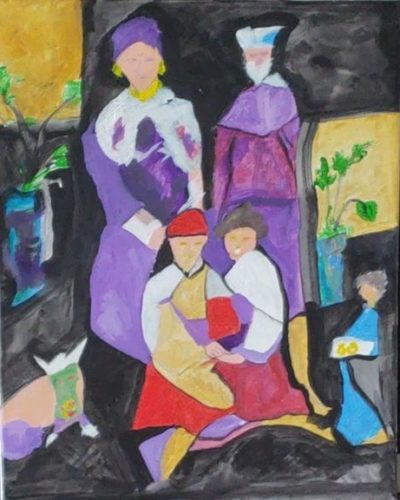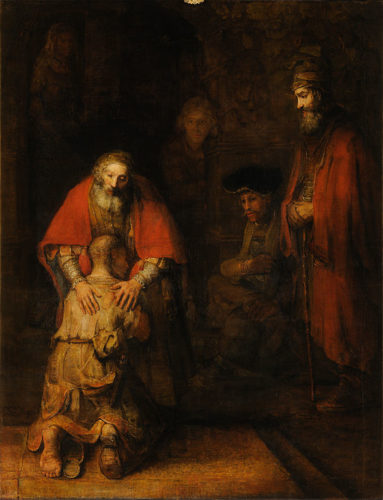Last Updated on March 26, 2025 by Kittredge Cherry

“Prodigal Son and His Husband Receive a Blessing” and “The Prodigal Transgender Daughter” are among new resources that reveal LGBTQ-positive meanings in the well-known Bible story.
The parable of the Prodigal child from Luke 15 will be read at many churches worldwide as the reading for Sunday, March 30, 2025 in the three-year lectionary cycle.
The story offers a picture of God’s boundless love as the parent rejoices over the rebellious child who returns home. Florida artist JR Leveroni turns the welcome-home feast into a same-sex wedding. Other LGBTQ-friendly materials on the Prodigal include books, videos and articles.
Leveroni painted the scene in a colorful modern style that he calls “evolved Impressionism.” In the Bible, the father gives a ring to his son and then hosts a feast in his honor. The 2019 painting goes a step further by adding the Prodigal Son’s husband. Here gold TWO gold rings are presented — for the son AND his husband. The father gives his blessing to the gay couple. The Prodigal’s welcome-home feast has become a same-sex wedding!
LGBTQ views of the Prodigal child
 LGBTQ-friendly resources on the Prodigal include the book “One Coin Found: How God’s Love Stretches to the Margins” by Emmy Kegler, a queer Lutheran pastor and editor of Queer Grace online encyclopedia. It is on Q Spirit’s list of the top LGBTQ Christian books of 2019.
LGBTQ-friendly resources on the Prodigal include the book “One Coin Found: How God’s Love Stretches to the Margins” by Emmy Kegler, a queer Lutheran pastor and editor of Queer Grace online encyclopedia. It is on Q Spirit’s list of the top LGBTQ Christian books of 2019.
In Luke 15:1-32, Jesus tells about the Prodigal as a response to religious authorities who criticized him for welcoming sinners. He describes a reckless or “prodigal” son who “squandered his wealth in wild living” in a distant country. Then he returned home, hoping only to be treated as a servant. Instead his father welcomed him back with a party so lavish that it angered his other son.
Parables are deliberately open to multiple meanings. LGBTQ interpretations usually put the LGBTQ person in the role of the Prodigal Son, also known as the Prodigal Child, Prodigal Daughter, Prodigal Queer or simply the Prodigal. For example, a gay man lying beside the man he will marry still grieves over the letters returned unopened by his father in the poem “The Prodigal Son’s Lament” from the book “Burnings” by Ocean Vuong. Transgender filmmaker Kimberly explores family issues that arise when she returns for her 20th high school reunion as a trans woman in the documentary “Prodigals Sons.”
Susan Cottrell, founder and president of FreedHearts, also retells the story in a trans-affirming way on the video “The Prodigal Transgender Daughter.” Cottrell is the author of “ ‘Mom, I’m Gay’: Loving Your LGBTQ Child and Strengthening Your Faith.”
Leveroni painting adds the Prodigal son’s husband
The title alone awakens liberating and unforeseen possibilities. “Prodigal Son and his husband receive a blessing” raises questions such as:
Did the Prodigal Son come home to come out as gay? To give his family a chance to accept or reject the truth of his sexual orientation or gender identity?
What if the Prodigal Son fell in love with a man while he was away — and brought his new husband home with him?
Can this be a model for churches to welcome back LGBTQ members that they used to condemn?

“The Return of the Prodigal Son” by Rembrandt van Rijn (Wikipedia)
Leveroni’s paintings cover a wide variety of religious subjects, including such LGBTQ-oriented works as “Saint Sebastian and Matt Shepard Juxtaposed” and “(Saint) Mychal Judge being Welcomed by the Franciscan Saints.” Both paintings appear on Q Spirit. His vision of the Prodigal is based on “The Return of the Prodigal Son” by 17th-century Dutch master Rembrandt, bringing a contemporary queer perspective to the Renaissance masterpiece. He recasts the scene in lavender, a color associated with the LGBTQ community. His his enlightened world, even the fattened calf joins the festivities instead of being eaten.
Dutch theologian Henri Nouwen, who wrestled with his own homosexuality, wrote about his spiritual journey based on an encounter with this Rembrandt painting in his bestseller “The Return of the Prodigal Son: A Story of Homecoming.” In that book, Nouwen wrote, “God is looking into the distance for me, trying to find me, and longing to bring me home.”
More LGBTQ resources on the Prodigal child
Click the following links for LGBTQ-affirming reflections on the Prodigal child:
“Coming Home and Coming Out,” a sermon on the “prodigal queer” by Lindsey Becker for Edgewood Presbyterian Church
One Coin Found: “Lost” — an excerpt from “One Coin Found: How God’s Love Stretches to the Margins” by Emmy Kegler
“Hearing Our Stories” by Bryce Rich
En español / In Spanish:
Chapter 24. “¿Cómo leer la parábola del hijo pródigo desde una experiencia gay?” in
“Solo un Jesús marica puede salvarnos: Reflexiones cristianas en clave gay” by Carlos Osma
___
Top image credit:
“Prodigal Son and His Husband… Receive a Blessing” by JR Leveroni of Evolved Art
___
This post is part of the LGBTQ Saints series by Kittredge Cherry. Traditional and alternative saints, people in the Bible, LGBT and queer martyrs, authors, theologians, religious leaders, artists, deities and other figures of special interest to lesbian, gay, bisexual and transgender and queer (LGBTQ) people and our allies are covered.
This article was originally published on Q Spirit in March 2019, was expanded with new material over time, and was most recently updated on April 15, 2024.
Copyright © Kittredge Cherry. All rights reserved.
Qspirit.net presents the Jesus in Love Blog on LGBTQ spirituality.





















The Bible says the Prodigal Son squandered his money on prostitutes, rather than returning home with a male lover (or any other lover, for that matter). It also says he repented of his sin rather than continuing to live in sin, which is why he was welcomed back home. This shouldn’t need to be pointed out since it’s obvious from the text.